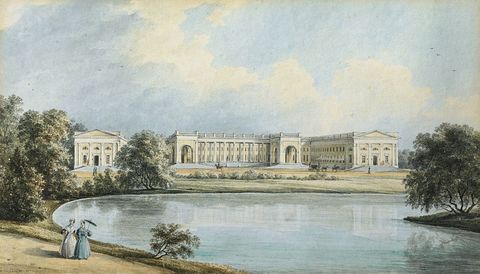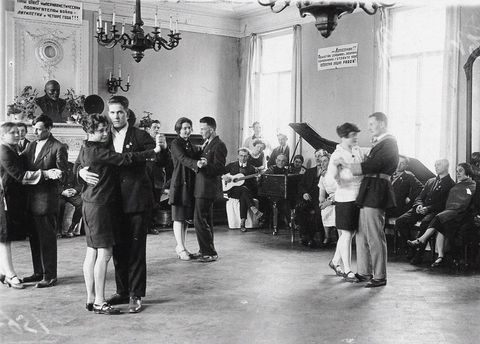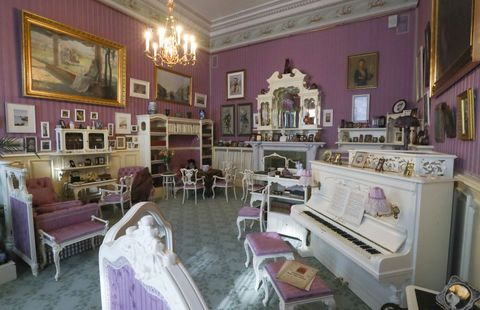What Is the Name of the Last Ruling Family in Russia Who Was Russias Last Ruling Monarch
Tsar Nicholas II'southward favorite palace—the dwelling to which he retreated later on he abdicated the throne—was 1 of the Romanov's about honey residences. Its rooms were filled with books, art, and treasures collected by generations of the Russian purple family. Now, after years of research and plush reconstruction to its private chambers, the palace has been restored and is open to the public.
Curators used faded one-time photographs and antiquarian paintings as their guide while recreating the Alexander Palace's decor and assembling personal effects that had long ago been dispersed to other museums and individual collections. The result of their work offers an intimate look into the lives of Tsar Nicholas 2, Empress Alexandra Feodorovna, and their 5 children.
The palace'due south close association with the last members of Russian federation's ruling monarchy presented a dilemma for Soviet-era leaders, who did not desire to glorify a past that had been so violently rejected. Every bit a result, the residence remained in limbo—sort of a museum merely too a catch-all government building. Here's how its fortunes waxed and waned over the class of the last century.
Beginning of the End
On March 15, 1917, after a cord of military losses to the Germans, an outbreak of food riots across the state, and open revolt in the ranks of the royal ground forces, Tsar Nicholas II of Russia abdicated his throne, ending more than 300 years of rule by the Romanov dynasty. He signed a annunciation, accustomed the title of "Colonel" from the Russian Conditional Government, and retreated to the Alexander Palace, the lavish mansion built by Catherine the Smashing in 1792. His married woman, Alexandra Feodorovna, and their v children awaited him in that location.
Situated 15 miles due south of Leningrad in Tsarskoe Selo, the former summer home offered physical and symbolic distance from the turmoil in the city. Nicholas had, in fact, made the palace his master residence for exactly that reason before long after the political uprisings of 1905, which saw massive street protests nigh the Winter Place and the Encarmine Sun massacre during which the Majestic troops attacked and killed crowds of marchers also equally bystanders.
Only what had once been a beatific retreat for Nicholas quickly became a prison house. Guards armed with rifles watched the family unit'due south every motility. Nicholas was allowed little contact with the outside world, and his daily activities, including walks on the park's grounds, were closely controlled. In August of that year, he and his family were moved to Siberia and so to the Ural mountains. On July 17, 1918, they were executed forth with their servants and royal attendants.
A Personal Favorite
Nicholas II and Alexandra had delighted in living at the Alexander Palace and information technology was closely associated with their life together. The edifice is surrounded by extensive grounds on which the couple had taken walks and had picnics with their young children. They planted gardens and entertained friends out of view of the public and members of the royal courtroom. And they made numerous improvements to the construction, including adding electric wiring and creating cozy, less formal family unit rooms, including one decorated in a then scandalously practical Art Nouveau way. Like the other palaces, it was a symbol of empire, but information technology was besides comfortable family home.
Other Romanovs had too adored the Alexander Palace. Catherine the Peachy deputed the palace in 1792 for her eldest grandson, Alexander I. Subsequently he became emperor, he turned it over to his brother, Nicholas I, who commissioned major renovations and redecorations and spent as much fourth dimension there with his family unit every bit possible. When Nicholas I ascended to the throne in 1825, the palace was turned over to a series of future heirs including somewhen Alexander III, whose son Nicholas Two was built-in in the palace in 1868.
After the Revolution
Alexander Palace stood empty for a brief period later on Nicholas departed but was and then converted into a museum as well as an orphanage and convalescent home for soldiers. It remained relatively unchanged until World War 2, when Germans captured information technology en route to laying siege to Saint petersburg.
The Nazis turned information technology into a headquarters for officers, many of whom pillaged artwork and personal effects. (Soviet curators managed to pack upwards a few of the palace'south most valuable treasures before the enemy arrived, some of which they sent past rail auto to Siberia; other items were hidden in the basement.) After the state of war, the palace was briefly fabricated into a museum again before existence turned over to the Soviet navy in the 1950s, which used it as a headquarters and academy until the 1990s.
Many Romanov palaces, including the Winter and Catherine, were restored and turned into museums during Soviet rule. But the Alexander Palace remained closed to the public despite the fact information technology had escaped WWII relatively undamaged. Preserving a rejected past proved a thorny undertaking for the country'due south Soviet leaders, and it was a particularly delicate procedure with this edifice because of its association with the last Romanov emperor.
Starting From Scratch
For a long time, Soviet authorities maintained that at that place wasn't much left of the Romanov legacy in the Alexander Palace to preserve. Rooms had been stripped of all furnishings, they said, and unabridged sections had been damaged beyond recognition during the war. Nonetheless, preservationists inside and outside of the country clamored to become into the building to start restoration. Ane of them was Bob Atchison, a Texas native who has made saving the palace his life-long passion.
In 1975, he flew to St. Petersburg and, every bit he describes it, "smuggled himself into the building." He was delighted with what he establish. "I talked my way past the guards and I could immediately see that many architectural details remained intact," he told T&C during a recent telephone call. "Some of the rooms had been either preserved or carefully restored. Information technology was far from the full loss that the Soviet guides told Western tourists."
Atchison returned to the city numerous times later that start trip and befriended Anatoly Mikhailovich Kuchumov, the influential curator who had overseen the transport of many valuables from the Leningrad palaces before the Nazis attacks. Kuchomov gave Atchison albums of photographs, which he had digitized, and that the duo and then published on a website that Atchison created and maintains to this day. "At a time when [the regime] were saying the palace was destroyed and nothing was saved. We had all these pictures of its interiors that showed what was really there."
Interest in the palace picked up after the collapse of the Soviet Union. In 1996, the World Monuments Fund donated $150,000 to assist restore its roof. Individual donors like Atchison made contributions to its repair and soon small portions of the palace, including the restored Portrait Hall, Marble Cartoon Room, and Semi-Circular Hall, were opened to the public. In 2014, the Russian regime committed to a major restoration, which was unveiled last summer.
The piece of work took historians and curators years of painstaking inquiry. Rugs, tapestries, and prints were recreated by hand, and new wooden floors laid to match ones researchers could see in erstwhile photographs. If, during Soviet times, the goal of previous caretakers had been to deemphasize Nicholas Ii's connection to the palace, modernistic restorers sought to bring back every detail of his life there. "They've washed such a remarkable job," said Atchison. "I merely wish Kuchumov were live today to meet it."
The restoration piece of work will continue as curators turn their attention next to the guest and servants' quarters in the palace's westward wing.
Alexander Palace is function of the Tsarskoe Selo State Museum And Heritage Site, which offers calendar and planning tools for scheduling a visit.
This content is created and maintained by a tertiary party, and imported onto this page to help users provide their email addresses. You may be able to observe more information about this and like content at piano.io
Source: https://www.townandcountrymag.com/leisure/travel-guide/a39011364/romanov-alexander-palace-russia-restored/





0 Response to "What Is the Name of the Last Ruling Family in Russia Who Was Russias Last Ruling Monarch"
Post a Comment